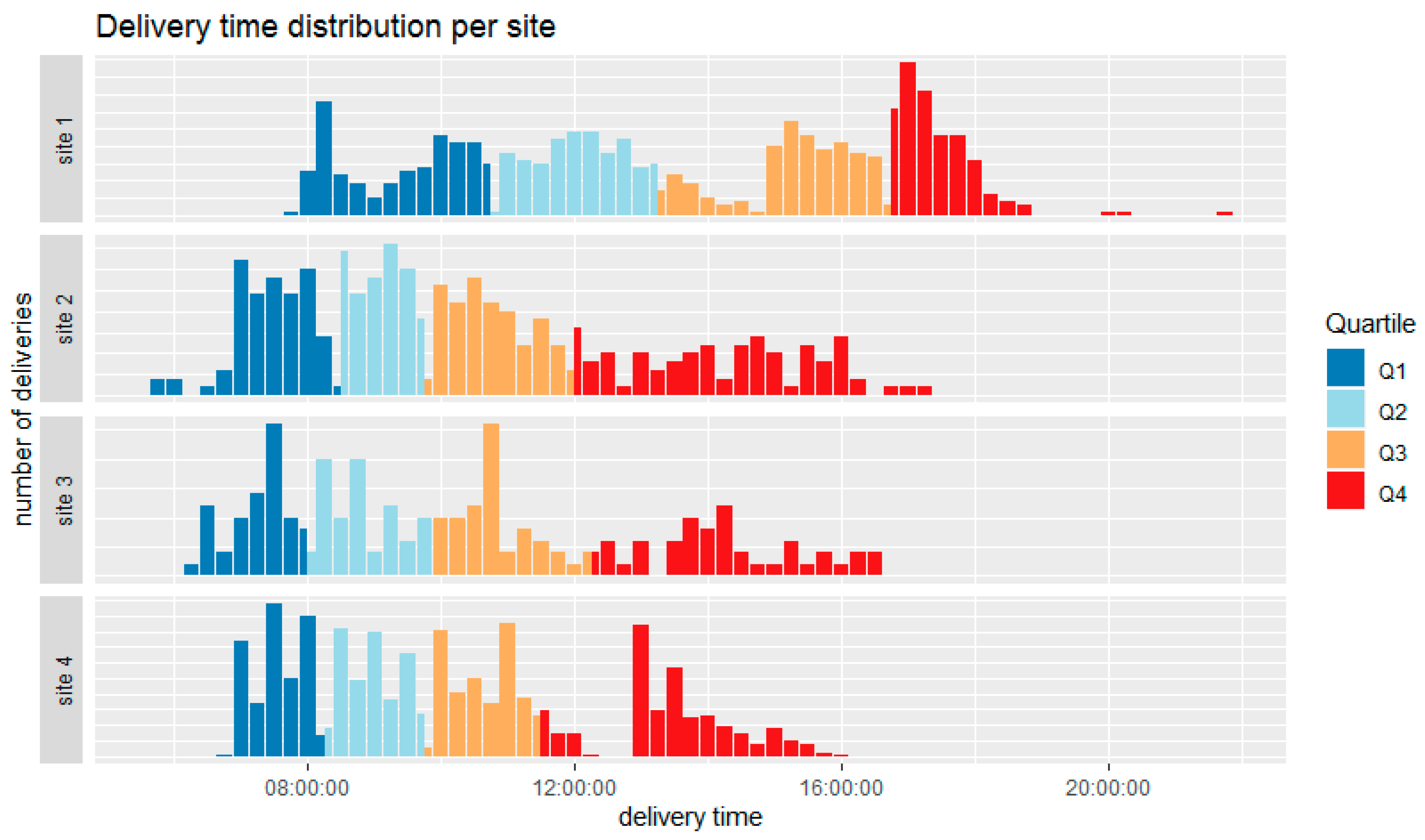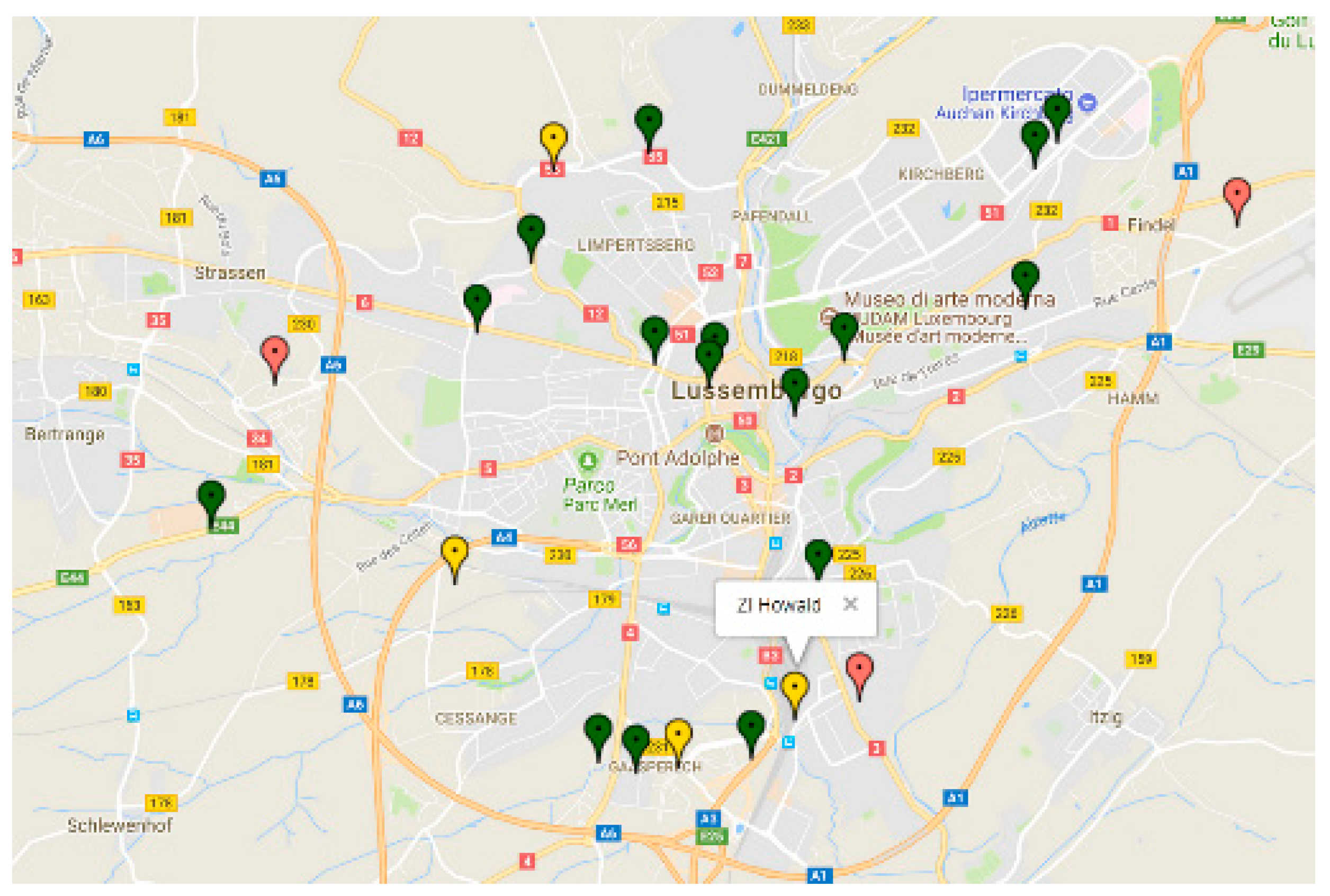Understanding Construction Logistics in Urban Areas and Lowering Its Environmental Impact: A Focus on Construction Consolidation Centres
Abstract
:1. Introduction
2. Methodology
3. Overview of the Construction Sites
3.1. Neudorf Breweries Complex in Luxembourg City (LU)
3.2. Fontenoy-Ségur Complex in Paris (FR)
3.3. Parque Central—Russafa in Valencia (ES)
3.4. Borgo Trento Hospital in Verona (IT)
4. Comparison of the UFT Patterns between the Four Construction Sites
4.1. Stakeholders
4.2. Vehicles
4.3. Handling of Building Materials
4.4. Deliveries
4.5. Logistics Organization
4.6. Regulation
5. Comparison with Other Commonly Observed UFT Patterns
6. Approaches Transforming Construction Supply Chains
- (a)
- Initial data for each country are collected to generate stochastic scenarios. For example, for the pilot case of Luxembourg, six CCC candidates locations have been identified by the pilot and its stakeholders, four of them being represented in Figure 2. In addition, the pilot and its stakeholders provided assumptions on future construction sites, material demand, and vehicles types.
- (b)
- These data are used to feed a mathematical model of the stochastic facility location problem, using a mixed integer linear programming solver, which gives the optimal choice for the CCCs location, i.e., the location that lowers the material flows (km × m3) over the simulation period (three years).
- (c)
- Then, with the choice of the optimal CCC location for each city, scenarios are assessed: No use of CCCs (baseline) versus use of CCC(s) for one or several construction sites with vehicle allocation and routing optimisation on the second echelon (only) or on both echelons. A set of C++ programs run the simulations for the distances and times of the flows in the different scenarios. Readers interested in the mathematical models used at each step are suggested to read [13].
- (d)
- The results of this evaluation are next used both by the COPERT© software and by cost-benefit analysis models to evaluate, respectively, the pollutant emissions and the economical sustainability and opportunity of using the CCC(s).
- (e)
- The results for each scenario are compared to the baseline (no use of CCCs).
7. Conclusions
Author Contributions
Funding
Acknowledgments
Conflicts of Interest
References
- UN DESA. United Nations 68% of the World Population Projected to Live in Urban Areas by 2050, Says UN; United Nations Department of Economic and Social Affairs: New York, NY, USA, 2018. [Google Scholar]
- Koskela, L. Application of the New Production Philosophy to Construction; Technical Report No. 72; CIFE: Nice, France; Stanford University: Stanford, CA, USA, 1992; p. 81. [Google Scholar]
- Groves, D. The construction industry’s productivity problem. In The Economist; The Economist Group: London, UK, 2017. [Google Scholar]
- Dablanc, L. Freight Transport for Development Toolkit: Urban Freight; The World Bank: Washington, DC, USA, 2009; pp. 1–57. [Google Scholar]
- Schoemaker, J.; Allen, J.; Huschebek, M.; Monigl, J. Quantification of urban freight transport effects I. BESTUFS Consort. 2006, 76. [Google Scholar]
- Dablanc, L. City Distribution, a Key Element of the Urban Economy: Guidelines for Practitioners. In City Distribution and Urban Freight Transport; Edward Elgar Publishing: Cheltenham, UK, 2011; ISBN 978-0-85793-275-4. [Google Scholar]
- Unimore; et al. Simulation results. In SUCCESS Project; Brussels, Belgium, 2018; p. 231. [Google Scholar]
- McKinsey. Imagining Construction’s Digital Future; McKinsey: New York, NY, USA, 2016. [Google Scholar]
- Serouge, M.; Patier, D.; Routhier, J.-L.; Toilier, F. Enquête Marchandises en Ville Réalisée en Île-de-France Entre 2010 et 2013; HAL: Paris, France, 2014; p. 126. [Google Scholar]
- Taniguchi, E. City Logistics: Modelling, Planning and Evaluation; Routledge: Abingdon, UK, 2017; ISBN 978-1-317-50404-7. [Google Scholar]
- Guerlain, C.; Renault, S.; Ferrero, F. Urban Freight: What about Construction Logistics; TRA: Vienna, Austria, 2018. [Google Scholar]
- LIST; et al. Report on good practices in the EU and USA in construction logistics in urban area. In SUCCESS Project; Brussels, Belgium, 2017; p. 88. [Google Scholar]
- Unimore; et al. Mathematical programming tools for construction logistics optimisation problems. In SUCCESS Project; Brussels, Belgium, 2017. [Google Scholar]
- Guerlain, C.; Renault, S.; Ferrero, F.; Faye, S. Decision Support Systems for smarter and sustainable construction logistics. Sustainability 2019, 11, 2762. [Google Scholar] [CrossRef]


| Construction Site | Neudorf Breweries Complex | Fontenoy-Ségur Complex | Parque Central—Russafa | Borgo Trento Hospital |
|---|---|---|---|---|
| Site location | Luxembourg City (LU) | Paris (FR) | Valencia (ES) | Verona (IT) |
| Population density (inh/km2) | 2100 | 21,339 | 5841 | 1259 |
| Budget (€ million) | 20.8 | 230 | 15.8 | 126 |
| Site area (m2) | 6796 | 14,400 | 115,460 | 16,891 |
| Footprint (m2) | 3132 | 13,000 | 7515 | 7339 |
| Gross floor area (m2) | 11,400 | 55,475 | 7772 | 44,034 |
| Site 1 | Site 2 | Site 3 | Site 4 | |
| Number of shippers | 35 | 66 | 14 | 46 |
| Vehicle type+ (representing 80% of cumulated deliveries) | dump truck (76.5%) | trailer (30.0%) | articulated lorry (42.7%) | mini-van (36.59%) |
| semi-trailer (21.0%) | semi-trailer (34.66%) | |||
| semi-trailer (12.0%) | chassis cab (13.1%) | |||
| chassis cab (28.63%) | ||||
| cab (11.1%) | truck (42.7%) | |||
| truck (9.9%) | ||||
| Average travel distance (back and forth)* | 69.7 km | 170 km | 441 km | 169 km |
| Direct trips+ | 99% | 18% | 100% | 100% |
| Scheduled deliveries+ | 100% | 73% | 13% | 66% |
| Site 1 | Site 2 | Site 3 | Site 4 | |
| Truck arrival time on site | min = 08:45 | min = 06:45 | min = 07:15 | min = 07:45 |
| 25% arrive before Q1 | Q1 = 11:45 | Q1 = 09:30 | Q1 = 09:00, | Q1 = 09:15 |
| 50% arrive before Q2 | Q2 = 14:15 | Q2 = 10:45 | Q2 = 10:45 | Q2 = 11:00 |
| 75% arrive before Q3 | Q3 = 17:45 | Q3 = 13:00 | Q3 =13:15 | Q3 = 12:30 |
| max = 22:45 | max = 18:15 | max = 17:30 | max = 17:00 | |
| Average duration of unloading* | ~47 min | ~1 h | ~34 min | ~45 min |
| Average duration of stops* | ~18 min | ~24 min | ~36 min | ~36 min |
| Average number of deliveries per day | 5 | 3 | 2 | 10 |
| Average number of pick-ups per day | 5 | 2 | 1 | 6 |
| Average driving duration (one way)* | ~20 min | ~1.5 h | ~2.5 h | ~2.5 h |
| Average stop duration outside the site* | ~4 min | ~12 min | ~14 min | ~36 min |
| Most frequent loading unit+ | pallet (59.8%) | pallet (39.8%) | pallet (82.6%) | pallet (65.3%) |
| Goods handling equipment+ (representing 80% of cumulated deliveries) | N/A | crane (58.9%) truck crane (29.4%) | forklift (68.4%) crane (22.2%) | forklift (53.0%) lift (35.0%) |
| Average weight* | 9.9 tons | 8.3 tons | 9.7 tons | 9.9 tons |
| Dimension | Generic UFT | Construction-Related UFT |
|---|---|---|
| Supply chain validity | Permanent | Temporary |
| Organisational mode | Multi-drop round | Single-drop trip |
| Delivery scheduling | Moderate use, both fixed time and time window | Highly used, mostly fixed time |
| Duration of stops | Short stop duration (around 15 min) | Long stop duration (around 45 min) |
| Delivery frequency | 3 to 10 deliveries per week | 12.5 to 50 deliveries per week |
| Vehicle size | LGVs | HGVs |
| Loading unit | Boxes | Pallets |
| Operation type | 2 deliveries for 1 pickup | |
| Delivery point/Storage | Fixed storage capacity | Scalable, temporary and moveable storage capacity |
| Digitalisation of the delivery process | High | Low |
| Loading areas | Fixed public space provided by cities (loading bays) | Private or public space provided by main contractors |
| Expected Benefits | Indicators | Luxembourg City * | Paris * | Valencia * | Verona * |
|---|---|---|---|---|---|
| Reduction of congestion | Daily number of freight vehiclesa | Up to 48% | Up to 42% | Up to 48% | Up to 54% |
| Reduction of pollutant emissions | CO2 emissions | Up to 33% | Up to 13% | Up to 31% | Up to 19% |
| NOx emissions | Up to 41% | Up to 8% | Up to 39% | Up to 22% | |
| PMx emissions | Up to 30% | Up to 23% | Up to 26% | Up to 19% | |
| Reduction of vehicle use & route optimisation | Travelled distance | Up to 42% | Up to 20% | Up to 34% | Up to 23% |
| Small deliveriesb | Up to 100% | Up to 100% | Up to 100% | Up to 100% | |
| Maximise load factor | % Increase load factor | Up to 40% | Up to 52% | Up to 44% | Up to 232% |
| Economic savings | Payback | Year 1** | Year 1 | Year 1 | >5 years*** |
© 2019 by the authors. Licensee MDPI, Basel, Switzerland. This article is an open access article distributed under the terms and conditions of the Creative Commons Attribution (CC BY) license (http://creativecommons.org/licenses/by/4.0/).
Share and Cite
Guerlain, C.; Renault, S.; Ferrero, F. Understanding Construction Logistics in Urban Areas and Lowering Its Environmental Impact: A Focus on Construction Consolidation Centres. Sustainability 2019, 11, 6118. https://doi.org/10.3390/su11216118
Guerlain C, Renault S, Ferrero F. Understanding Construction Logistics in Urban Areas and Lowering Its Environmental Impact: A Focus on Construction Consolidation Centres. Sustainability. 2019; 11(21):6118. https://doi.org/10.3390/su11216118
Chicago/Turabian StyleGuerlain, Cindy, Samuel Renault, and Francesco Ferrero. 2019. "Understanding Construction Logistics in Urban Areas and Lowering Its Environmental Impact: A Focus on Construction Consolidation Centres" Sustainability 11, no. 21: 6118. https://doi.org/10.3390/su11216118
APA StyleGuerlain, C., Renault, S., & Ferrero, F. (2019). Understanding Construction Logistics in Urban Areas and Lowering Its Environmental Impact: A Focus on Construction Consolidation Centres. Sustainability, 11(21), 6118. https://doi.org/10.3390/su11216118





